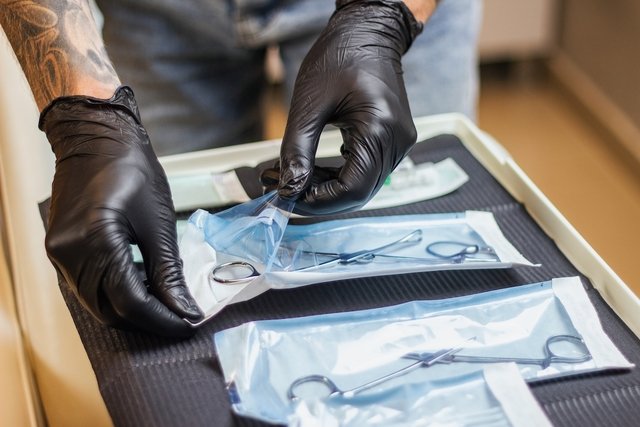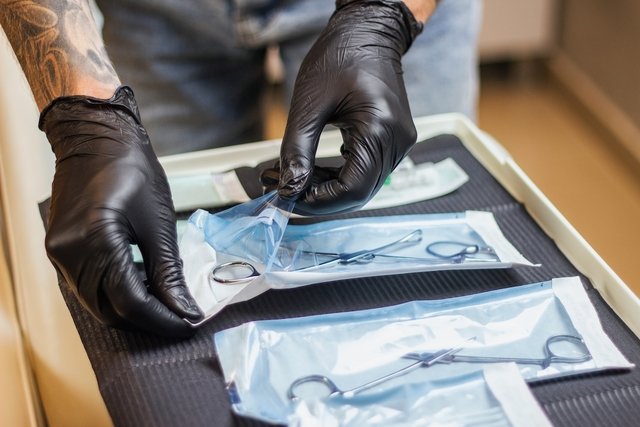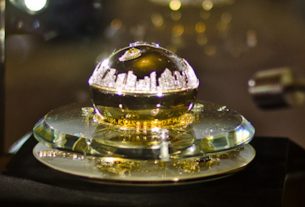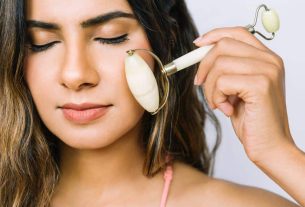One of the most important precautions when caring for a piercing is to carefully choose the place and professional where the procedure will be carried out, as it is very important that the environment is regulated to reduce the risk of infection.
Furthermore, before doing the piercing It is recommended to have an up-to-date vaccination record, especially tetanus and hepatitis vaccines, as procedures that involve cutting the skin carry a greater risk of causing infectious diseases.
After doing the piercing, it is normal for the area to be sore, swollen and red during the first few days. During this period it is important to maintain the piercing always clean and dry to avoid infection and also ensure that healing happens in the best way possible.

How to clean the piercing in the 1st month
Care during the first month after placement of the piercing are very important, as it is during this period that there is a greater risk of infection, inflammation and rejection of the piercing by the body.
To prevent this from happening and for healing to occur in the best possible way, it is important to take some precautions such as:
- Wash hands always before touching the piercing;
- Clean the skin around the piercing using gauze moistened with saline solution;
- Disinfect the area with gauze moistened with povidone-iodine or Povidine, for example;
- Finish by drying the area around the piercing using clean, dry gauze.
This care must be repeated 2 to 3 times a day, and it is also recommended to move and rotate the piercing at least twice a day, to prevent secretions from sticking to the piercing.
Furthermore, it is important to pay attention to your diet so that healing is favored and there is a lower risk of inflammation. Therefore, it is recommended to consume foods that contain anti-inflammatory substances, such as fish, seeds and vegetables. Check out a list of foods to combat inflammation and ensure better healing.
How to care for each type of piercing
Although the cleaning tips in the piercing can be used on any part of the body, each location needs special care, which includes:
- Piercing not nose: it is important to blow your nose several times a day, with a tissue and without squeezing, to avoid the piercing coming into contact with dirt in your nose;
- Piercing in the navel: sleeping on your stomach should be avoided, especially during the first month, and it is also recommended to wear loose clothing that does not rub or pull the skin. piercing;
- Piercing in the ear: It is important to avoid sleeping on the side of the piercing for the first two months;
- Piercing no finger: it is important to wear gloves when using strong cleaning products, such as bleach, for example, and it is also recommended to wash your hands with glycerin soap several times a day;
- Piercing on the eyebrow: it is recommended to avoid using beauty products in this region during the first month, such as foundations or concealers, for example;
- Piercing on the bottle: it is important to opt for soft and cold foods in the first two weeks after doing the piercing, choosing to eat yogurt, porridge and fruit juices, for example. Furthermore, it is also recommended to use a mouthwash after brushing your teeth;
- Piercing in the genital region: It is important to perform intimate hygiene at least 3 times a day, using warm water and mild intimate soap. In addition, you should focus on wearing cotton underwear and only wear loose clothing during the first month.
Complete healing of the piercing It takes about a month, and after that time it is possible to replace the piercing placed in the store, by another smaller one and made of anti-allergic material, which must be purchased in specialized and trustworthy stores, such as tattoo, piercing or goldsmith shops.
Check out, in the following video, some precautions you should take with the piercing:
What to do if the piercing ignite
Even taking all care when cleaning the piercingsome signs may appear that indicate that the surrounding skin is becoming inflamed or has an infection, such as local swelling, intense pain, intense redness, bleeding or the presence of pus.
In these cases, it is recommended to go to the emergency room so that appropriate treatment can be provided by a doctor or nurse. Treatment depends on the severity of the infection, and the use of painkillers or antibiotics may be necessary. Check out other precautions that should be taken when piercing ignite.
Main risks of doing one piercing
It is important to be careful and careful when deciding to place the piercing, as in some cases it can cause an allergic reaction, especially when the piercing is made of nickel, leading to itching, redness and pain in the area. Furthermore, when the piercing If they are not cleaned properly, especially in the first month, there is a risk of infection, which can be quite serious.
Some people have a greater tendency to form keloids, which corresponds to a scar that is more prominent than normal, and, therefore, having a piercing can encourage the appearance of scars.
In rarer and more serious cases, the use of a piercing can cause endocarditis, which is inflammation of the tissue that covers the heart and is caused by the spread of bacteria through the bloodstream, which may have entered the body through the inflamed piercing site. , which end up reaching the heart, putting the person’s life at risk.

Sign up for our newsletter and stay up to date with exclusive news
that can transform your routine!
Warning: Undefined array key "title" in /home/storelat/public_html/wp-content/plugins/link-whisper-premium/templates/frontend/related-posts.php on line 12
Warning: Undefined array key "title_tag" in /home/storelat/public_html/wp-content/plugins/link-whisper-premium/templates/frontend/related-posts.php on line 13





